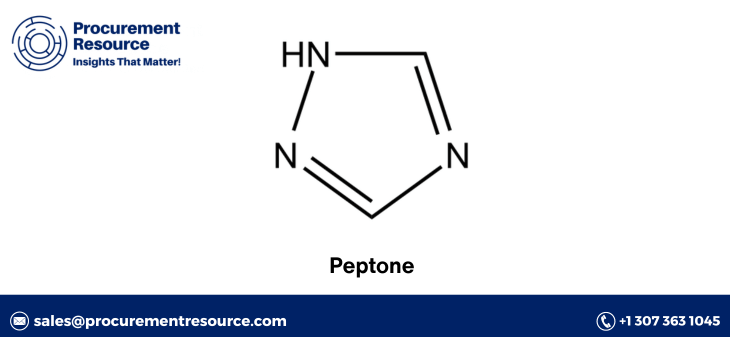Peptone, a vital organic compound, is widely used in microbiological culture media to grow a variety of microorganisms, including bacteria, fungi, and yeast. It is primarily composed of peptides and amino acids derived from the partial hydrolysis of proteins. The importance of peptone in biotechnology, pharmaceuticals, and food industries cannot be overstated, as it serves as a rich nutrient source for microbial growth and fermentation processes. This blog delves into the intricate peptone production process, providing insights into its manufacturing, raw material costs, and recent developments in the field.
Manufacturing Report and Process
1. Protein Source Selection
The production of peptone begins with the selection of an appropriate protein source. Commonly used sources include casein (from milk), meat, gelatin, soy, and fish. The choice of protein source significantly impacts the quality and application of the final peptone product. For instance, casein peptone is preferred for its high nitrogen content, while soy peptone is valued for its suitability in vegetarian media formulations.
Request For Sample: https://www.procurementresource.com/production-cost-report-store/peptone/request-sample
2. Hydrolysis Process
The core of peptone production is the hydrolysis process, where proteins are broken down into smaller peptides and amino acids. This can be achieved through:
- Acid Hydrolysis: In this method, the protein source is treated with strong acids, such as hydrochloric acid, at high temperatures. Acid hydrolysis is effective in breaking down proteins into smaller peptides but may result in the destruction of some sensitive amino acids.
- Enzymatic Hydrolysis: Enzymatic hydrolysis utilizes proteolytic enzymes, such as pepsin, trypsin, or papain, to degrade proteins. This method is milder and more specific, preserving the integrity of amino acids and resulting in a peptone with higher nutritional value.
3. Neutralization and Filtration
Following hydrolysis, the mixture is neutralized to achieve a pH suitable for microbial growth. This is typically done using alkaline substances like sodium hydroxide. The neutralized solution is then filtered to remove any undissolved particles or impurities, ensuring a clear peptone solution.
4. Concentration and Drying
The filtered peptone solution is concentrated through evaporation to reduce its volume and increase the concentration of peptides and amino acids. The concentrated solution is then dried using methods such as spray drying or freeze drying to obtain a powdered peptone product. Spray drying is commonly used for its efficiency and ability to produce fine, uniform particles.
5. Quality Control and Packaging
The final step in the peptone production process involves rigorous quality control to ensure the product meets industry standards. Parameters such as peptide content, nitrogen content, solubility, and microbiological purity are tested. Once the product passes quality control, it is packaged in sterile, moisture-proof containers to maintain its stability and shelf life.
Raw Material Costs
The cost of raw materials plays a crucial role in the overall economics of peptone production. Key factors influencing raw material costs include:
1. Protein Source
The price of the chosen protein source is a significant cost driver. Casein and meat peptones tend to be more expensive due to the higher cost of milk and meat proteins. In contrast, soy and gelatin peptones are generally more affordable.
2. Enzymes and Chemicals
For enzymatic hydrolysis, the cost of proteolytic enzymes can be substantial, especially if high-purity enzymes are used. Acid hydrolysis, on the other hand, incurs costs related to strong acids and neutralizing agents.
3. Energy and Utilities
Energy costs for heating, hydrolysis, concentration, and drying processes contribute to the overall production cost. Efficient energy use and optimization of processing conditions can help mitigate these expenses.
4. Quality Control and Packaging
Ensuring high-quality standards through rigorous testing and using specialized packaging materials also adds to the production cost. However, this is crucial for maintaining product integrity and meeting regulatory requirements.
Latest News
The peptone market is continually evolving, driven by advancements in biotechnology and increasing demand from various industries. Some of the latest developments include:
1. Innovations in Hydrolysis Techniques
Recent research has focused on optimizing enzymatic hydrolysis to enhance yield and nutritional quality of peptones. Advances in enzyme technology and the use of novel enzymes are expected to improve the efficiency and cost-effectiveness of peptone production.
2. Sustainable Protein Sources
There is a growing interest in utilizing sustainable and alternative protein sources for peptone production. Insects, algae, and plant-based proteins are being explored as potential sources to reduce reliance on traditional animal-derived proteins and address environmental concerns.
3. Market Expansion
The global peptone market is expanding, with increasing demand from the pharmaceutical, biotechnology, and food industries. This growth is attributed to the rising use of peptones in microbial fermentation, cell culture, and diagnostic media.
4. Regulatory Developments
Regulatory agencies are implementing stricter guidelines for peptone production to ensure product safety and quality. Compliance with these regulations is essential for manufacturers to maintain market access and consumer trust.
5. Collaborations and Partnerships
Industry collaborations and partnerships are becoming more prevalent, with companies joining forces to leverage expertise and resources. Such collaborations aim to drive innovation, improve production processes, and expand market reach.
Conclusion
Peptone production is a complex and multifaceted process, involving the careful selection of protein sources, precise hydrolysis techniques, and stringent quality control measures. The cost of raw materials, energy, and quality assurance significantly influences the overall production economics. As the demand for high-quality peptones continues to rise, ongoing research and innovation are crucial to enhancing production efficiency and sustainability. Keeping abreast of the latest developments in the peptone market will enable manufacturers to stay competitive and meet the evolving needs of various industries.
